Process Study and Simulation for the Recovery of 1,1,2,2,3,3,4−heptafluorocyclopentane by Reactive Distillation
Abstract
:1. Introduction
2. Materials and Methods
2.1. Materials
2.2. GC Analysis
2.3. Experimental Equipment and Procedures of Reactive Distillation
2.4. Reaction Kinetic Model
3. Results
3.1. Catalyst Screening
3.2. Kinetics of Intramolecular Dehydration of TAA Catalyzed by Zinc Chloride
3.2.1. Effect of Reaction Temperature on the Dehydration Reaction Rate of TAA
3.2.2. Reaction Kinetic Model
3.2.3. Effect of Distillation on the Reaction Rate
3.3. Optimization of Operating Conditions for Catalytic Reaction Distillation
3.3.1. Effect of Catalyst Amount on the Conversion of TAA
3.3.2. Effect of Reflux Ratio on the Purity and Recovery of F7A
3.3.3. Recovery Effect of F7A
3.4. Simulation of Reactive Distillation Process
3.4.1. Stage Number
3.4.2. Feed Stage
3.4.3. Reflux Ratio
3.4.4. Heat Duty
3.4.5. Analysis of Simulation Results in Distillation Columns
4. Conclusions
- (1)
- NKC−9 ion exchange resin, 3A molecular sieve, 13X molecular sieve, and zinc chloride can catalyze TAA dehydration reaction, among which zinc chloride displays the highest catalytic performance and the longest life.
- (2)
- The kinetic data of TAA dehydration reaction were measured, and the model parameters were fitted. According to the fitting results, pre−exponential factor (A = 4.86 × 1011) and activation energy (E = 89.99 kJ/mol) were calculated.
- (3)
- A dual−column distillation process was proposed and verified, through which the stage number, feed stage, reflux ratio, and reboiler heat duty were determined to be 26/26, 26/22, 4/2.5, and 0.075/0.12 kW in column 1 and column 2, respectively. Under the optimal process conditions, the recovery of F7A was 73.1% and the purity was 99.4%.
Supplementary Materials
Author Contributions
Funding
Conflicts of Interest
References
- Forster, P.; Storelvmo, T.; Armour, K.; Collins, W.; Dufresne, J.-L.; Frame, D.; Lunt, D.J.; Mauritsen, T.; Palmer, M.D.; Watanabe, M.; et al. The earth’s energy budget, climate feedbacks, and climate sensitivity. In Climate Change 2021: The Physical Science Basis. Contribution of Working Group I to the Sixth Assessment Report of the Intergovernmental Panel on Climate Change; Masson-Delmotte, V., Zhai, P., Pirani, A., Connors, S.L., Péan, C., Berger, S., Caud, N., Chen, Y., Goldfarb, L., Gomis, M.I., et al., Eds.; Cambridge University Press: Cambridge, UK; New York, NY, USA, 2021; pp. 923–1054. [Google Scholar]
- Zhang, C.P. Investigation on Synthesis of 1H,1H,2H-Heptafluorocyclopentane; Beijing Institute of Technology: Beijing, China, 2017; pp. 1–5. [Google Scholar]
- Sasaki, Y.; Hanawa, Y.; Nadahara, S.; UedaHiroaki, D.; Kitagawa, H.; Okumura, K. Substrate Treating Apparatus and Substrate Treating Method. U.S. Patent No. 10,153,181, 11 December 2018. [Google Scholar]
- Ando, K.; Otsuki, N. Release Solvent Composition, Release Method, and Cleaning Solvent Composition. European Patent No. 3,296,366, 5 September 2016. [Google Scholar]
- Bartelt, J.E. Azeotrope-Like Mixtures Comprising Heptafluorocyclopentane. U.S. Patent No. 7,540,973, 2 June 2009. [Google Scholar]
- Ando, K.; Sugawara, M. Recycling Method and Recycling Device for Cleaning Solvent Composition, and Cleaning Method and Cleaning System for Object to be Cleaned. Japanese Patent No. 2,019,552,767, 2 November 2018. [Google Scholar]
- Kiss, A.A.; Jobson, M.; Gao, X. Reactive distillation: Stepping up to the next level of process intensification. Ind. Eng. Chem. Res. 2019, 58, 5909–5918. [Google Scholar] [CrossRef] [Green Version]
- Yang, A.; Shen, W.; Wei, S.; Dong, L.; Li, J.; Gerbaud, V. Design and control of pressure-swing distillation for separating ternary systems with three binary minimum azeotropes. AIChE J. 2019, 65, 1281–1293. [Google Scholar] [CrossRef] [Green Version]
- Yang, A.; Sun, S.; Shi, T.; Xu, D.; Ren, J.; Shen, W. Energy-efficient extractive pressure-swing distillation for separating binary minimum azeotropic mixture dimethyl carbonate and ethanol. Sep. Purif. Technol. 2019, 229, 115817. [Google Scholar] [CrossRef]
- Liang, S.; Cao, Y.; Liu, X.; Li, X.; Zhao, Y.; Wang, Y. Insight into pressure-swing distillation from azeotropic phenomenon to dynamic control. Chem. Eng. Res. Des. 2017, 117, 318–335. [Google Scholar] [CrossRef]
- Rameshwar, S.H.; Nitin, V.B.; Yogesh, S.M. Industrial applications of reactive distillation: Recent trends. Int. J. Chem. React. Eng. 2004, 2, 1–51. [Google Scholar]
- Kiss, A.A. Novel catalytic reactive distillation processes for a sustainable chemical industry. Top. Catal. 2019, 62, 1132–1148. [Google Scholar] [CrossRef] [Green Version]
- Kaymak, D.B. Design and control of an alternative bioethanol purification process via reactive distillation from fermentation broth. Ind. Eng. Chem. Res. 2019, 58, 1675–1685. [Google Scholar] [CrossRef]
- Park, J.; Jeong, Y.; Han, M. Process intensification of reactive distillation using improved RCMs: Acetic acid production. Chem. Eng. Processing-Process Intensif. 2020, 157, 108136. [Google Scholar] [CrossRef]
- Kiss, A.A. Heat-integrated reactive distillation process for synthesis of fatty esters. Fuel Process. Technol. 2011, 92, 1288–1296. [Google Scholar] [CrossRef]
- An, W.Z.; Lin, Z.X.; Chen, J. Simulation and analysis of a reactive distillation column for removal of water from ethanol–water mixtures. Ind. Eng. Chem. Res. 2014, 53, 6056–6064. [Google Scholar] [CrossRef]
- Yadav, G.D.; Joshi, A.V. Etherification of tert-amyl alcohol with methanol over ion-exchange resin. Org. Process Res. Dev. 2001, 5, 408–414. [Google Scholar] [CrossRef]
- Marıa, A.P.; Bringue, R.; Iborra, M.; Tejero, J.; Cunill, F. Kinetic study of 1-butanol dehydration to di-n-butyl ether over amberlyst. AIChE J. 2016, 62, 180–194. [Google Scholar]
- Cunill, F.; Vila, M.; Izquierdo, J.F. Effect of water presence on methyl tert-butyl ether and ethyl tert-butyl ether liquid-phase syntheses. Ind. Eng. Chem. Res. 1993, 32, 564–569. [Google Scholar] [CrossRef]
- Nguyen, C.M.; Reyniers, M.F.; Marin, G.B. Theoretical study of the adsorption of the butanol isomers in H-ZSM-5. J. Phys. Chem. C 2011, 115, 8658–8669. [Google Scholar] [CrossRef] [Green Version]
- Nel, R.J.J.; Klerk, A.D. Dehydration of C5−C12 linear 1-alcohols over η-alumina to fuel ethers. Ind. Eng. Chem. Res. 2009, 48, 5230–5238. [Google Scholar] [CrossRef]
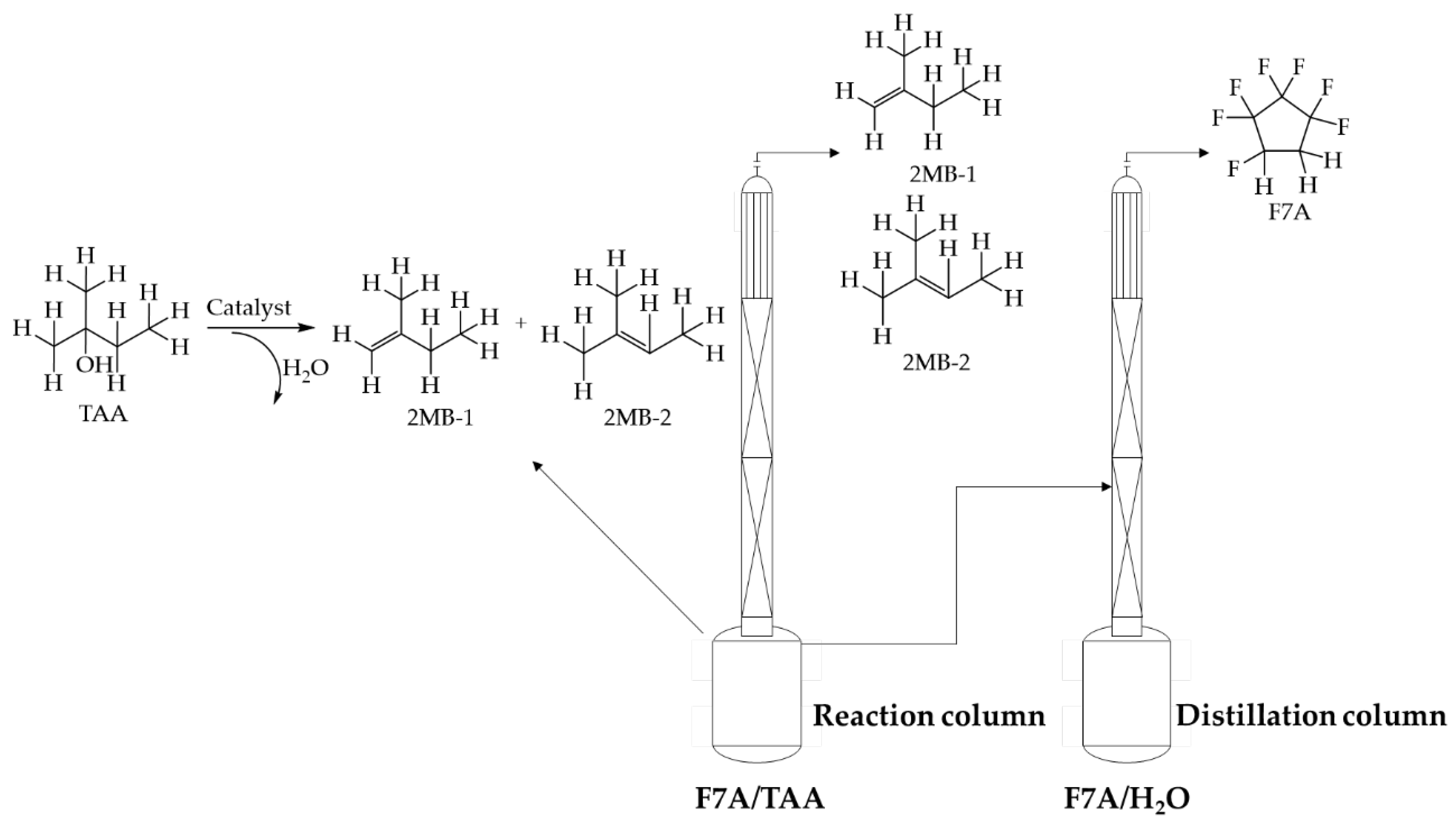
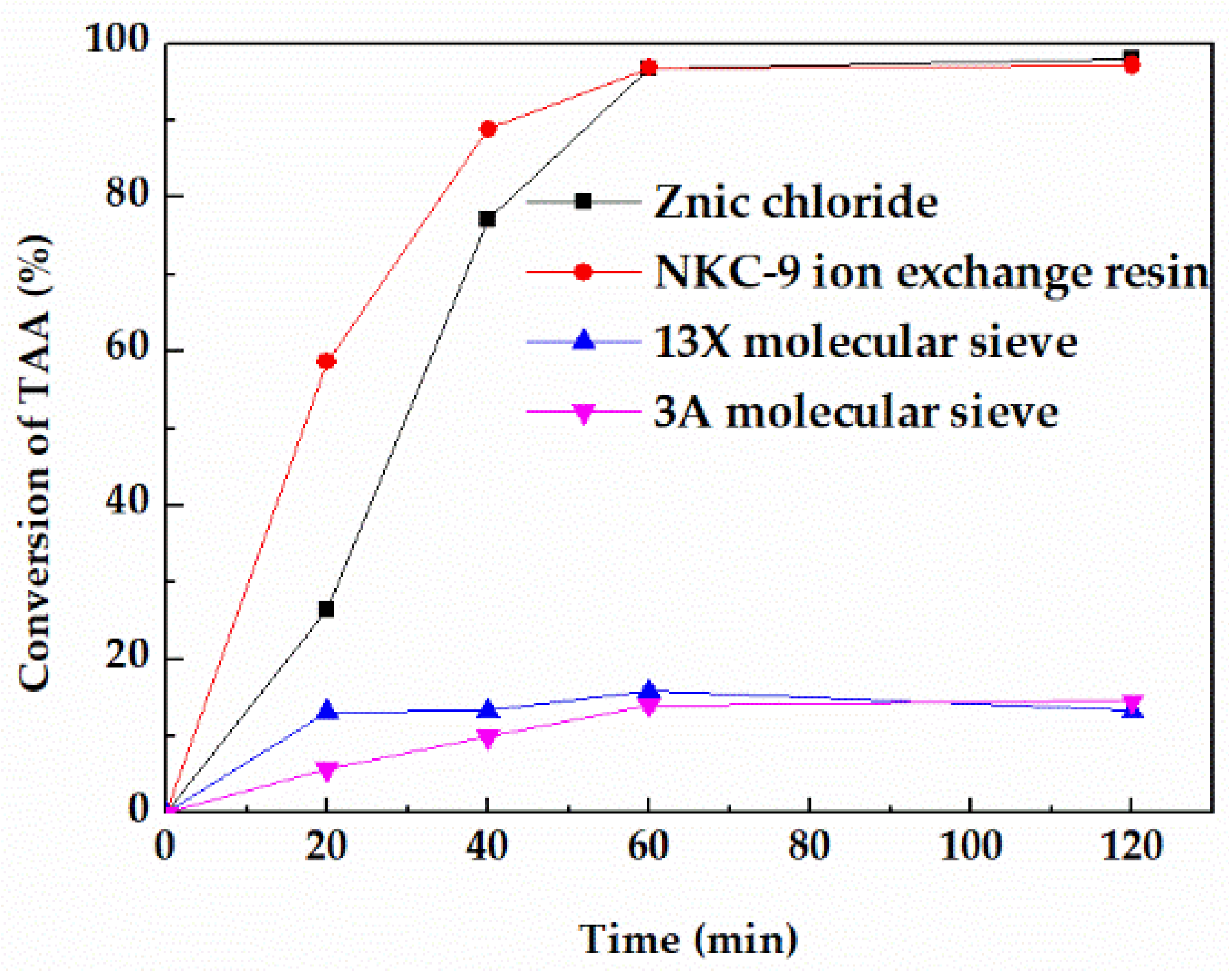
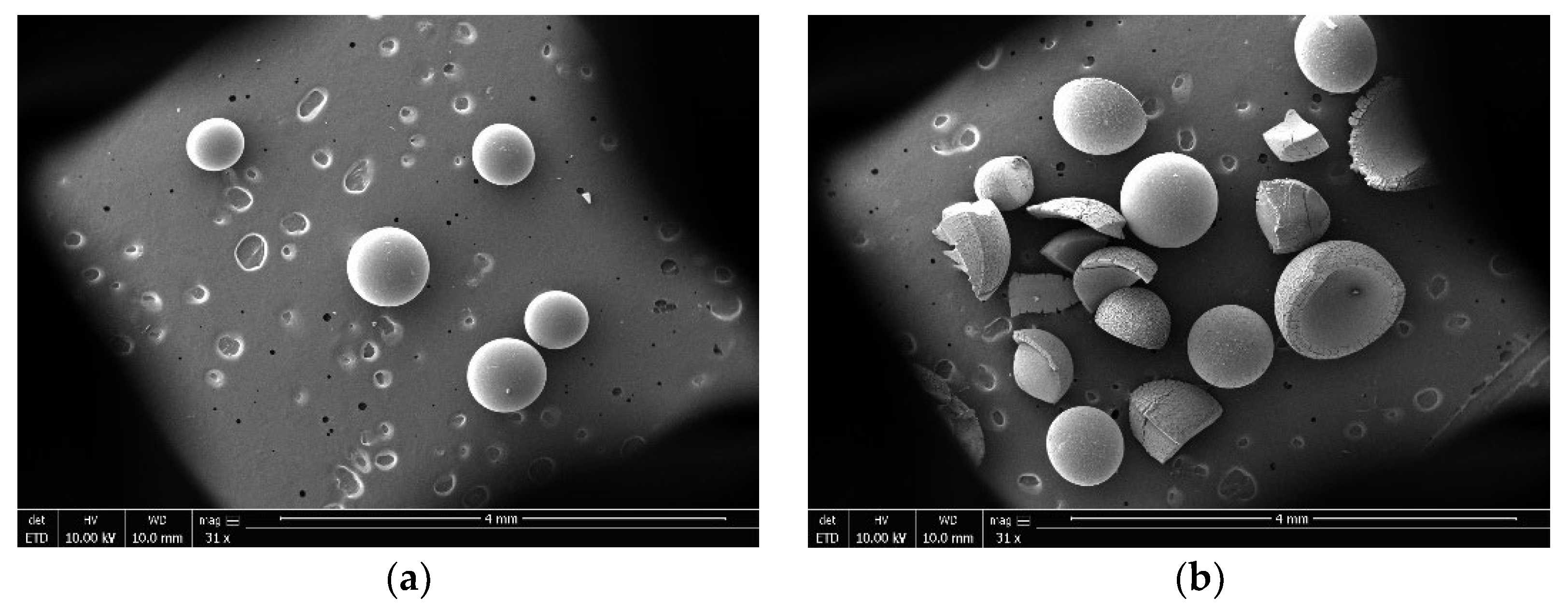

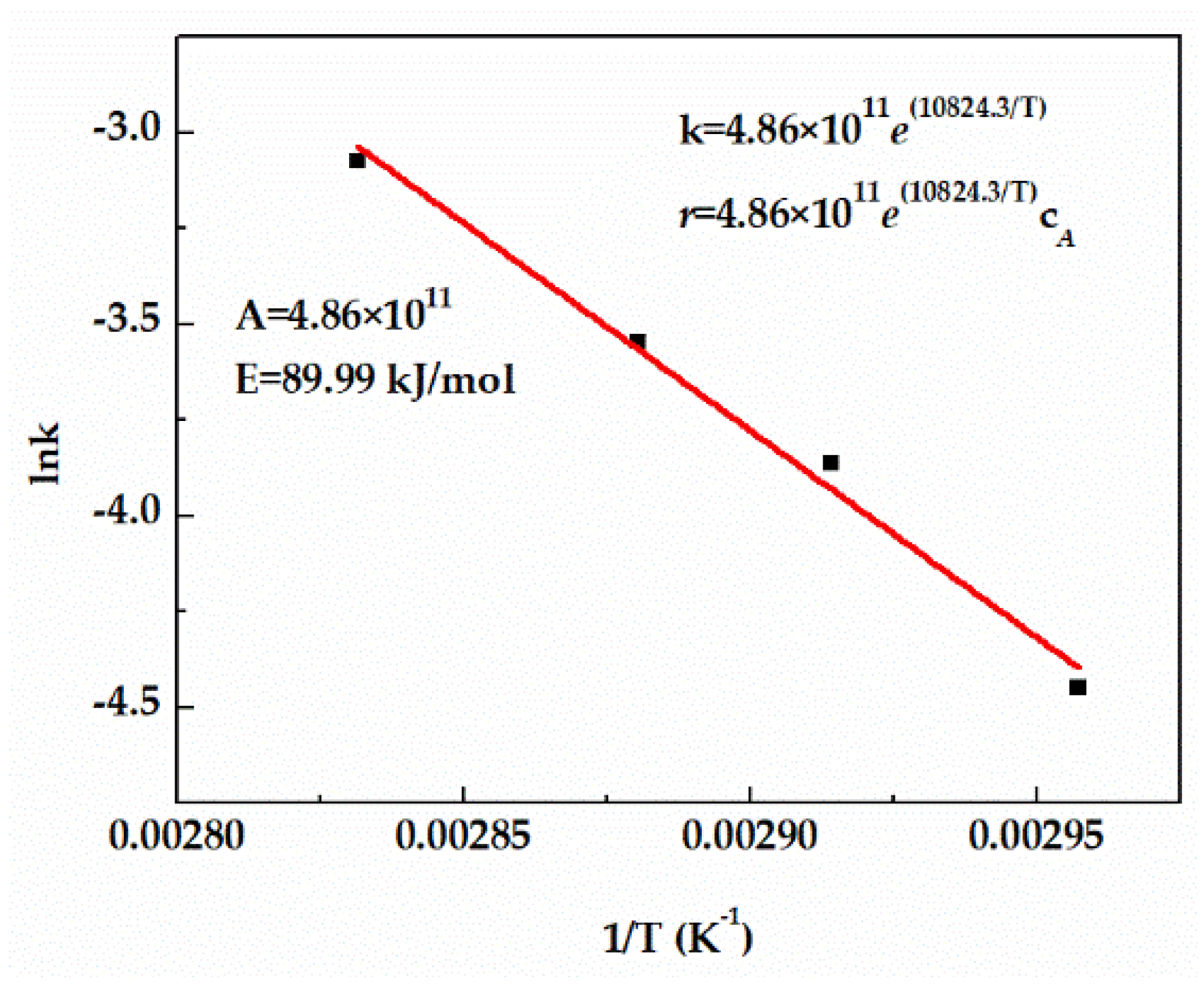

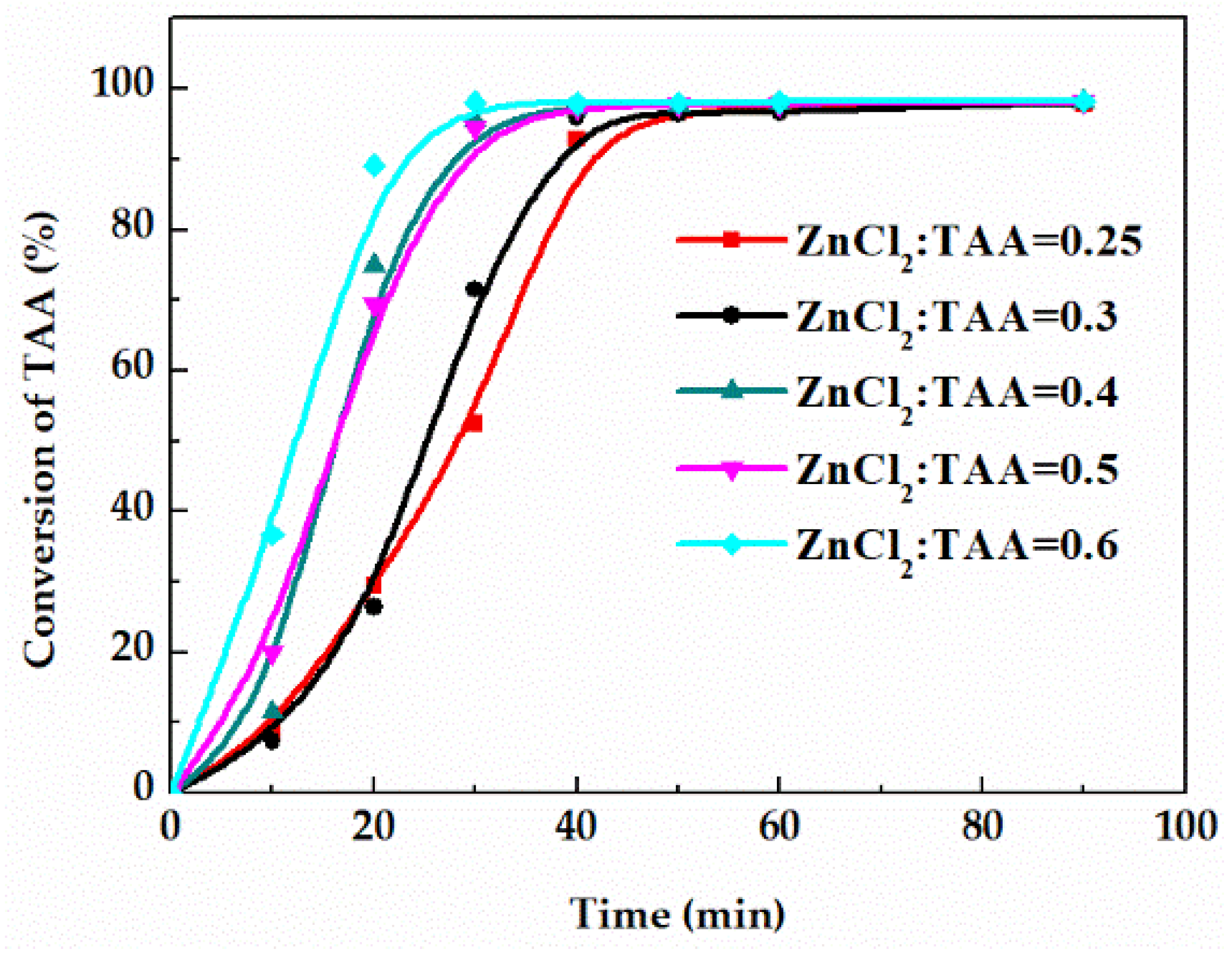
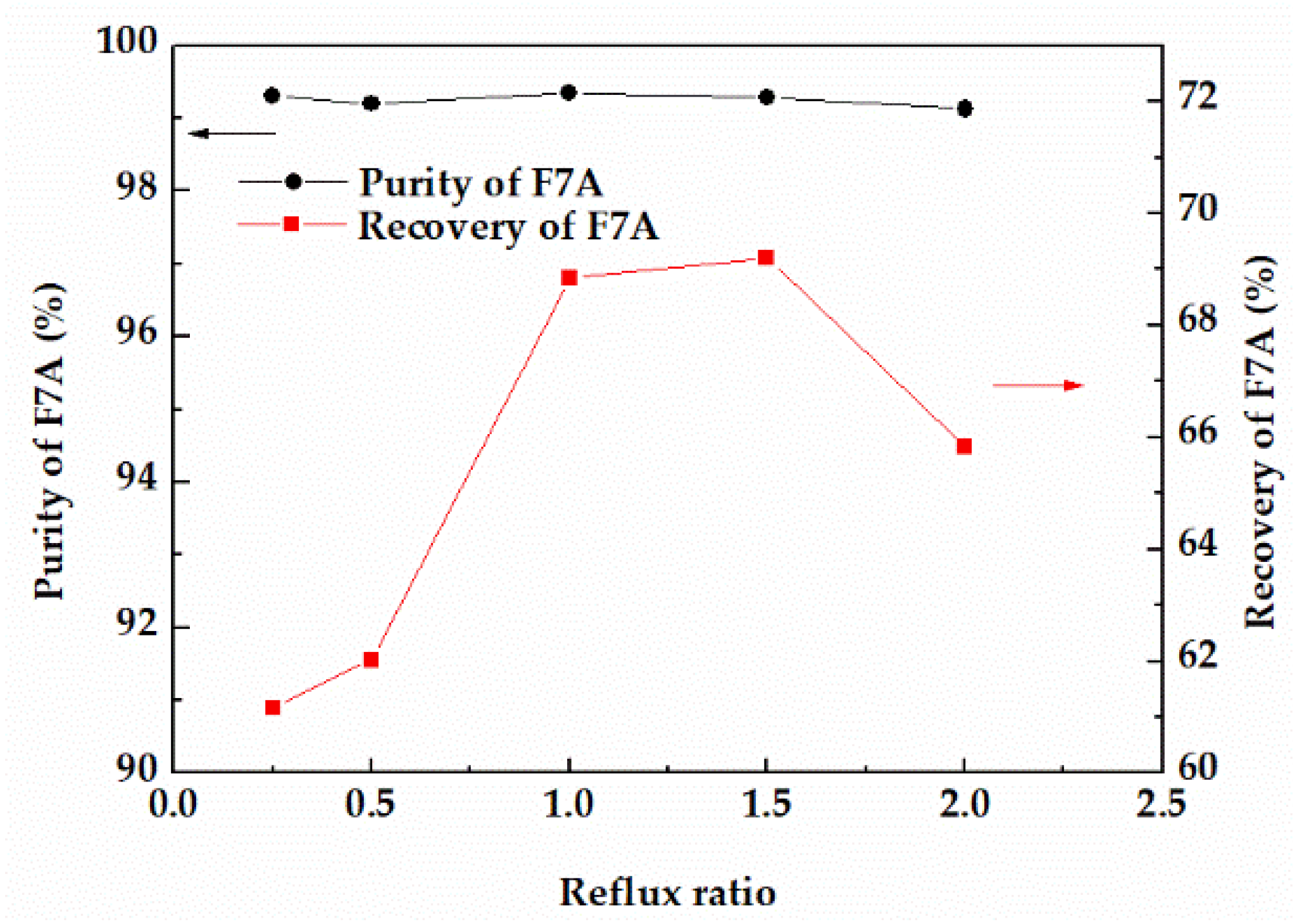
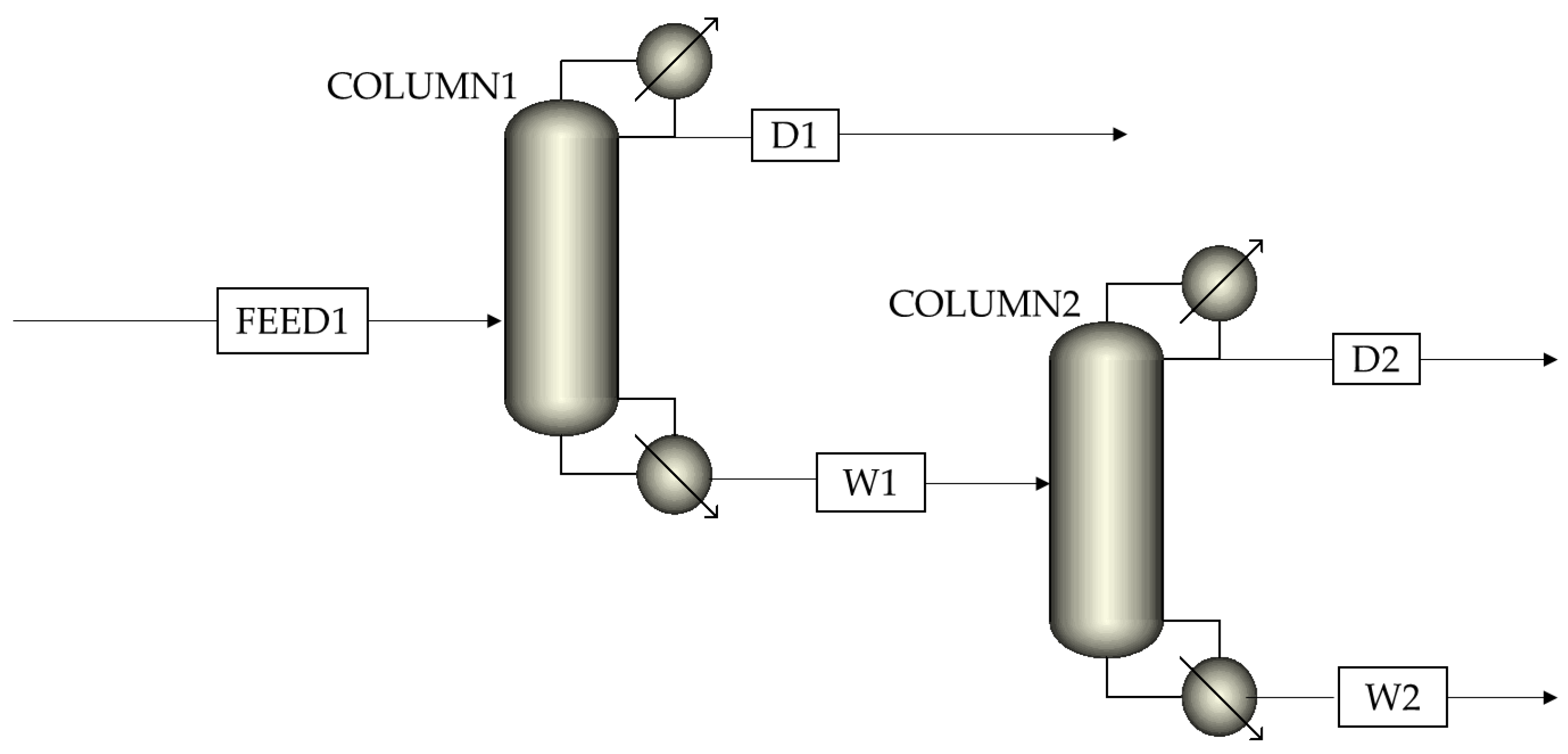




| Serial No. | Feed Quantity (kg) | Catalyst Amount (kg) | Purity (%) | Recovery (%) |
|---|---|---|---|---|
| 1 | 13.8 | 0.58 | 99.2 | 70.1 |
| 2 | 13.9 | 0.53 | 99.1 | 73.0 |
| 3 | 14.1 | 0.54 | 99.0 | 71.8 |
| 4 | 14.0 | 0.62 | 99.0 | 73.5 |
| 5 | 14.0 | 0.51 | 99.1 | 65.5 |
| Average | / | / | 99.1 | 70.8 |
| Feed Parameters | Column 1 | Column 2 | |||
|---|---|---|---|---|---|
| Pressure | 0.1 MPa | Pressure | 0.1 MPa | Pressure | 0.1 MPa |
| Vapor fraction | 0 | Reflux ratio | 1 | Reflux ratio | 1 |
| Mass flow | 1kg/h | Heat duty | 0.068 kW | Heat duty | 0.032 kW |
| Mass fraction | F7A/TAA = 95/5 | Number stages | 20 | Number stages | 20 |
| Streams | FEED | D1 | W1 | D2 | W2 |
|---|---|---|---|---|---|
| Mass flow(kg/h) | 1.00 | 0.275 | 0.725 | 0.699 | 0.026 |
| Mass fraction | |||||
| F7A | 0.95 | 0.87 | 0.98 | 0.994 | 0.896 |
| TAA | 0.05 | 4.73 × 10−9 | 1.97 × 10−6 | 2.14 × 10−6 | 8.77 × 10−7 |
| H2O | 0 | 9.4 × 10−8 | 0.014 | 4.49 × 10−6 | 0.104 |
| 2−MB−1 | 0 | 0.065 | 0.0025 | 0.003 | 1.85 × 10−9 |
| 2−MB−2 | 0 | 0.065 | 0.0027 | 0.003 | 2.0 × 10−8 |
| Parameters | Column 1 | Column 2 |
|---|---|---|
| Number of stages | 26 | 26 |
| Reflux ratio | 4 | 2.5 |
| Feed stage | 26 | 22 |
| Heat duty/kW | 0.075 | 0.12 |
Publisher’s Note: MDPI stays neutral with regard to jurisdictional claims in published maps and institutional affiliations. |
© 2022 by the authors. Licensee MDPI, Basel, Switzerland. This article is an open access article distributed under the terms and conditions of the Creative Commons Attribution (CC BY) license (https://creativecommons.org/licenses/by/4.0/).
Share and Cite
Mo, Y.; Dong, L.; Zhang, C.; Quan, H. Process Study and Simulation for the Recovery of 1,1,2,2,3,3,4−heptafluorocyclopentane by Reactive Distillation. Processes 2022, 10, 1146. https://doi.org/10.3390/pr10061146
Mo Y, Dong L, Zhang C, Quan H. Process Study and Simulation for the Recovery of 1,1,2,2,3,3,4−heptafluorocyclopentane by Reactive Distillation. Processes. 2022; 10(6):1146. https://doi.org/10.3390/pr10061146
Chicago/Turabian StyleMo, Yue, Li Dong, Chengping Zhang, and Hengdao Quan. 2022. "Process Study and Simulation for the Recovery of 1,1,2,2,3,3,4−heptafluorocyclopentane by Reactive Distillation" Processes 10, no. 6: 1146. https://doi.org/10.3390/pr10061146
APA StyleMo, Y., Dong, L., Zhang, C., & Quan, H. (2022). Process Study and Simulation for the Recovery of 1,1,2,2,3,3,4−heptafluorocyclopentane by Reactive Distillation. Processes, 10(6), 1146. https://doi.org/10.3390/pr10061146





